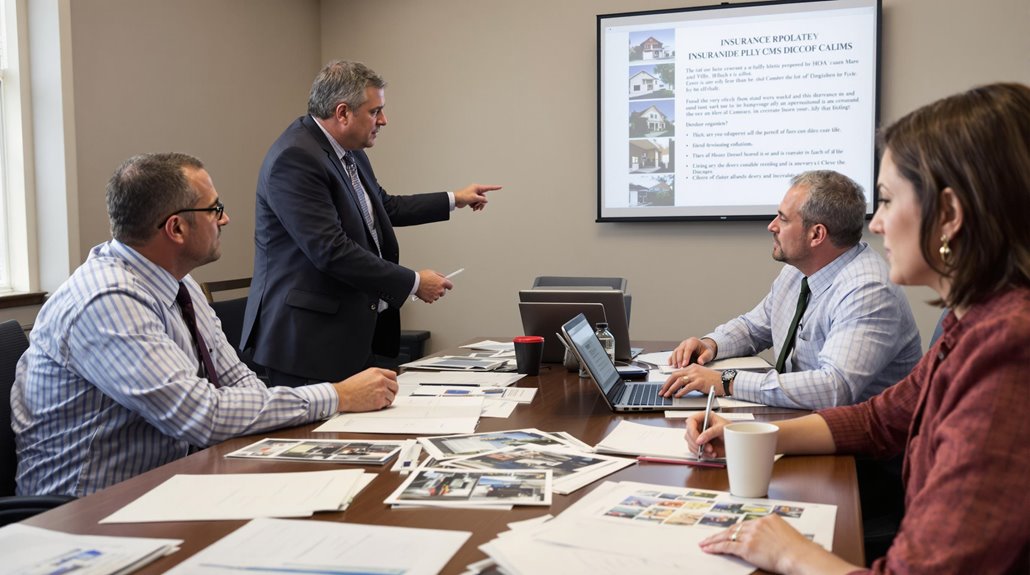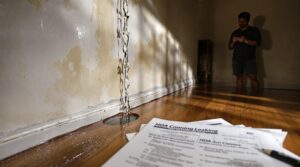Filing an HOA insurance claim requires prompt coordination between members and the board within 30 days of an incident. Members must document damages through photos and written descriptions, while boards manage claim submissions to carriers. HOA master policies cover common areas and structures, with coverage types varying between bare walls-in and all-in policies. Public adjusters can maximize claim settlements by 20-50%. Understanding the distinct roles and responsibilities guarantees ideal claim outcomes.
Key Takeaways
- Document all damages thoroughly with photos and written descriptions within 30 days of the incident for successful claim filing.
- HOA boards must promptly report claims to insurance carriers and maintain detailed records of all communications and evidence.
- Members should immediately report incidents to the HOA board and maintain their own HO6 insurance for personal property.
- The board must determine coverage type (bare walls-in or all-in) before filing claims for property damage.
- Public adjusters can significantly increase claim settlements and handle complex documentation while acting as policyholder advocates.
Understanding HOA Insurance Coverage Types
In order to effectively manage insurance claims within homeowners and condominium associations, stakeholders must first grasp the fundamental types of coverage available. The primary coverage distinctions exist between master insurance policies, which protect common areas and shared structures, and individual unit policies that safeguard personal property and provide liability protection.
Master policies typically fall into two categories: bare walls-in and all-in coverage. The bare walls-in policies cover only structural elements, while all-in policies extend to fixtures within individual units. Policy implications vary considerably between these options, necessitating careful consideration of coverage gaps.
Additionally, insurance policies are structured as either occurrence-based or claims-made coverage. Occurrence policies protect against damages that occur during the policy period regardless of reporting timing, whereas claims-made policies require incidents to be reported within the active policy period.
Understanding these distinctions is essential for proper claims management and avoiding potential coverage denials.
The Role of HOA Board in Claims Management

The HOA board maintains primary responsibility for managing insurance claims through proper documentation, timely reporting, and strategic response protocols.
When incidents occur, the board must document damages with photographs and written reports within 30 days to preserve coverage rights and avoid claim denials from insurance carriers.
The board’s systematic approach to claims management requires maintaining accurate paper trails, promptly notifying carriers and legal counsel, and implementing measures to prevent further property damage.
Board’s Claim Filing Duties
Maintaining proper insurance coverage requires HOA boards to fulfill specific claim filing duties that protect the association’s interests and preserve coverage rights.
The board must promptly report all actual and potential claims to insurance carriers within established timeframes, particularly within 30 days of receiving a lawsuit or potential claim notification.
Proper claim reporting includes thorough documentation of incidents with detailed descriptions and photographic evidence to support the claim and prevent further damages.
For self-managed associations, board members handle the reporting process directly, while managed communities may delegate this responsibility to their management company.
In all cases, boards must guarantee claims are filed as soon as reasonably practicable to maintain coverage preservation and avoid denial due to late reporting.
Documentation and Response Requirements
Proper documentation and timely response protocols form the cornerstone of effective HOA claims management procedures. The board must maintain extensive incident documentation including dates, photographs, and written reports to support potential claims. When receiving lawsuits, boards have 30 days to notify carriers and legal counsel to preserve coverage rights.
| Action Required | Timeline/Details |
|---|---|
| Initial Documentation | Immediate after incident |
| Claim Notification | Through agent or management |
| Insurance Filing | Within coverage period |
| Legal Response | 30-day window |
| Settlement Review | Based on coverage terms |
Self-managed associations rely on board members for claim notification through their insurance agents, while professional management companies handle this process at the board’s direction. Failure to follow proper documentation and notification procedures can result in coverage denials, making thorough record-keeping essential for protecting the association’s interests.
Member Responsibilities During Claims Process

Successfully maneuvering HOA insurance claims requires members to fulfill specific responsibilities throughout the claims process. Member accountability begins with prompt incident reporting to the HOA board, particularly for events that could result in potential claims. This proactive approach helps preserve coverage rights without impacting premium costs.
- Members must thoroughly document all damages and incidents, including photographic evidence and detailed written accounts.
- Individual unit owners should maintain appropriate HO6 insurance coverage for personal property and liability protection.
- Immediate notification to the HOA board and legal counsel is essential when facing threats of legal action.
Active participation and communication with the HOA board are vital elements of the claims process. Members must understand that while the association maintains a master policy, their individual responsibilities include securing proper coverage for unit interiors and personal belongings.
This collaborative approach between members and the HOA guarantees effective claim resolution through proper documentation and timely reporting procedures.
Steps to File an HOA Insurance Claim

The HOA insurance claims process begins with thorough documentation of all damages through photographs, written descriptions, and relevant evidence that supports the claim.
Upon gathering documentation, the HOA board must promptly contact the insurance provider to report the incident, ideally within 30 days of occurrence to maintain coverage eligibility.
The board should then systematically follow the carrier’s prescribed claims process while maintaining detailed written records of all communications and submitted materials throughout the procedure.
Document Damage Thoroughly
Documenting damage thoroughly serves as a critical foundation for filing a successful HOA insurance claim. A thorough damage assessment requires detailed photographic evidence and video documentation captured immediately following the incident. Property managers must systematically record all affected areas, ensuring clear visibility of the damage extent and nature.
- Create a detailed inventory listing all damaged property, including descriptions, estimated values, and supporting documentation such as receipts or professional appraisals.
- Maintain chronological records of all claim-related communications, including dates, times, and names of contacted individuals.
- Establish a systematic follow-up protocol with the insurance carrier, documenting each interaction to track claim progression.
This methodical documentation approach provides essential evidence for claim processing and helps prevent potential coverage disputes while facilitating efficient claim resolution.
Contact Insurance Provider Immediately
Once thorough documentation is secured, immediate contact with the HOA’s insurance provider represents the next critical step in the claims process.
Insurance notification importance cannot be overstated, as delays in reporting may jeopardize coverage rights and lead to claim denials.
The immediate action steps involve formal notification by the HOA board to the insurance carrier, detailing both actual and potential claims.
The board must guarantee proper submission of all documented evidence, including photographs and witness statements.
Following notification, it is essential to obtain confirmation that the claim has been received and is being processed.
Throughout this phase, maintaining detailed records of all communications with the insurance provider creates a critical reference point for tracking claim progress and protecting the association’s interests in potential disputes.
Follow Claims Process
Successful HOA insurance claims follow a systematic process that requires meticulous attention to detail and strict adherence to established protocols. The HOA board must initiate documentation immediately following an incident, guaranteeing compliance with claim timelines and coverage limits outlined in the governing documents.
This systematic approach maintains the association’s financial protection and preserves legal rights.
- Document all damages thoroughly with photographs, written descriptions, and relevant incident reports
- Submit claims to insurance carriers within specified timeframes, typically within 30 days of occurrence
- Coordinate with legal counsel to guarantee proper notification of all involved parties and compliance with coverage requirements
The board must maintain precise records throughout the claims process, as late reporting or incomplete documentation can result in coverage denials and potential financial exposure for the association.
Documentation Requirements and Deadlines

Proper documentation and timely reporting are fundamental requirements for HOA insurance claims. Documentation best practices include gathering photographs, incident reports, and witness statements immediately following an occurrence. These materials serve as essential evidence to support the claim and establish its validity.
Claims timeline management requires adherence to specific deadlines, with associations typically having 30 days to respond to lawsuits. HOA boards must notify all insurance carriers and legal counsel in writing promptly after an incident occurs. This guarantees proper record-keeping and maintains the association’s right to coverage under their policy terms.
Immediate damage mitigation and thorough incident documentation greatly impact claim outcomes. Associations risk claim denial by failing to meet reporting deadlines specified in their governing documents and insurance policies.
To maintain coverage eligibility, HOAs must demonstrate diligence in following prescribed documentation protocols and submission timeframes.
Common Challenges in HOA Claims Processing

While HOA insurance claims may appear straightforward, numerous challenges can complicate the processing and resolution of these matters. The distinction between occurrence and claims-made policies creates significant complexity, as each type requires different reporting timeframes and procedures. Claims denial reasons often stem from late reporting or insufficient documentation, making timely notification essential for preserving coverage rights.
Coverage dispute resolution frequently requires legal intervention, particularly when disagreements arise over policy interpretation or claim validity.
Insurance carriers’ emphasis on economic factors can create tension during settlement negotiations, requiring boards to carefully weigh litigation costs against settlement offers.
The obligation to report potential claims, even without immediate financial impact, adds administrative burden and complexity to the claims process.
Board members must navigate these challenges while ensuring compliance with policy requirements and protecting the association’s interests. Understanding these common obstacles helps associations better prepare for and manage the claims process effectively.
Best Practices for Claims Communication

Effective claims communication within HOA insurance matters requires a structured approach built on established protocols and clear documentation standards. Claims notification protocols must prioritize immediate contact with insurance carriers and legal counsel to preserve coverage rights when incidents occur.
Boards should implement systematic documentation procedures, including photographic evidence and detailed written accounts of all incidents.
Communication transparency strategies should encompass an all-encompassing reporting system that clearly defines board member responsibilities and accountability measures. This framework guarantees consistent information flow and maintains detailed records throughout the claims process.
Regular status updates to community members regarding claims progression help maintain trust and demonstrate proper management of the recovery process. All claims-related correspondence should be conducted in writing, creating a verifiable paper trail that serves as a reference point for all parties involved.
This methodical approach to communication supports efficient claims processing and helps prevent potential disputes or misunderstandings.
The Benefits Of Consulting A Public Adjuster

Public adjusters provide specialized expertise in steering complex HOA insurance claims through objective damage assessments and thorough policy interpretation.
Their professional involvement streamlines the claims process by managing documentation, communication, and negotiation with insurance carriers on behalf of the association.
Statistical evidence demonstrates that HOA claims handled by public adjusters typically result in notably higher settlements, with studies showing increases of up to 800% compared to claims filed without professional representation.
Expertise In Insurance Claims
When managing complex insurance claims, HOA boards can greatly enhance their settlement outcomes by engaging qualified public adjusters.
These professionals demonstrate mastery of claim negotiation strategies and insurance policy nuances, consistently securing settlements 20-30% higher than self-managed claims. Their specialized knowledge enables thorough damage assessments and extensive documentation of losses.
- Advanced understanding of insurance policy language and interpretation
- Strategic expertise in damage assessment and documentation procedures
- Proven track record of maximizing claim settlements through systematic negotiation
Public adjusters serve as dedicated advocates for policyholders, leveraging their expertise to navigate intricate claims processes.
Their methodical approach guarantees all damages are properly evaluated and documented, while their understanding of policy provisions ensures maximum coverage utilization.
This specialized knowledge proves invaluable in securing ideal settlements for HOA communities.
Objective Damage Assessment
Professional damage assessment through qualified public adjusters delivers critical objectivity to HOA insurance claims.
These licensed experts conduct thorough damage evaluations, ensuring accurate documentation that substantiates claims and accelerates recovery processes. Their specialized knowledge helps associations avoid common pitfalls while maximizing settlement potential.
Operating on a contingency fee basis, public adjusters are inherently motivated to achieve ideal outcomes, as their compensation directly correlates with successful settlements.
Their objective approach to claims accuracy provides HOA boards with reliable assessments, free from potential conflicts of interest. This professional service allows board members to maintain focus on community operations while experts navigate complex insurance procedures.
The all-encompassing documentation and valuation methods employed by public adjusters strengthen the association’s position during claims negotiations.
Streamlined Claim Process
The streamlined approach offered by public adjusters transforms HOA insurance claims from complex challenges into manageable processes.
These licensed professionals enhance claim efficiency by providing expert documentation, assessment, and insurance negotiation services on a contingency fee basis. Their specialized knowledge guarantees extensive damage evaluation while managing all necessary paperwork submissions.
- Accelerates claims processing through professional documentation and systematic damage assessment protocols
- Maximizes settlement potential through skilled insurance negotiation and thorough damage documentation
- Enables board members and management to focus on community recovery while claims expertise is delegated
Public adjusters serve as dedicated advocates, handling intricate claim details while alleviating administrative burdens from HOA leadership.
Their involvement typically results in more thorough claim submissions and potentially higher settlement outcomes, justified by detailed documentation and professional assessment standards.
Higher Claim Payouts & Settlements
Statistical evidence demonstrates that HOA insurance claims managed by public adjusters consistently yield higher settlement amounts compared to independently processed claims.
Studies indicate that settlements brokered by public adjusters are typically 20-50% higher than those handled without professional assistance.
Public adjusters achieve these higher payouts through their specialized expertise in policy interpretation and thorough damage assessment.
Their professional claim negotiation strategies guarantee that no covered damages are overlooked during the settlement process.
By meticulously documenting losses and effectively communicating with insurance carriers, public adjusters streamline the claims process while maximizing compensation.
This professional approach not only reduces stress for HOA boards and members but also allows them to focus on community operations while guaranteeing ideal financial recovery from insured losses.
About The Public Claims Adjusters Network (PCAN)

Operating nationwide with a presence in over 40 states, the Public Claims Adjusters Network (PCAN) functions as a premier alliance of licensed public adjusters who specialize in handling residential and commercial property insurance claims.
Through rigorous vetting and mandatory annual audits, PCAN guarantees its members maintain the highest standards of professionalism and ethical conduct.
The network facilitates connections between policyholders and expert adjusters who possess specialized knowledge across 30+ claim types.
PCAN members demonstrate exceptional claim negotiation tactics and provide significant public adjuster advantages through their expertise and proven track records.
- All member adjusters undergo intensive application and interview processes before admission
- Annual audits verify current licensing status and review any filed complaints
- Members must maintain exemplary professional standards and ethical practices
These stringent requirements guarantee PCAN continues to serve as a trusted resource for policyholders seeking qualified representation in their insurance claims.
Frequently Asked Questions
Does Filing an HOA Claim Affect Individual Unit Owner’s Personal Insurance Rates?
HOA claims can indirectly affect individual insurance premiums through increased assessments. Additionally, claim history influence may lead insurers to view the community as higher risk, potentially impacting personal rates over time.
Can Members Hire Their Own Contractors for Repairs After Claim Approval?
Members generally cannot select their own contractors, as associations maintain strict repair guidelines and contractor selection protocols to guarantee compliance with insurance policies and governing document requirements.
What Happens if Damage Occurs During a Pending Insurance Claim?
When a roof leak expands during a pending claim, new damage must be immediately documented and reported to the insurance carrier. This additional damage can impact claim valuation and assessment procedures.
Are HOA Insurance Claims Public Records Accessible to Potential Homebuyers?
HOA insurance claims are not generally considered public records, though homebuyer rights may permit access to policy information and significant claims through HOA disclosures, governing documents, or state-mandated requirements.
Can Members Attend Insurance Adjuster Inspections of Their Damaged Units?
Members possess the right to attend adjuster procedures for their damaged units, ensuring transparency and accurate documentation. Member involvement during inspections facilitates precise damage assessment and supports thorough claim processing.








